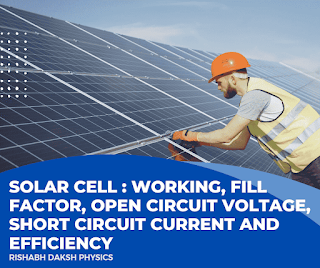Solar Cell: Working, Fill Factor, Open Circuit Voltage, Short Circuit Current and Efficiency
Introduction
Welcome to our comprehensive guide on solar cells, where we will delve into the intricacies of this remarkable technology. Solar cells, also known as photovoltaic cells, are devices that convert sunlight into electricity. In this article, we will explore the key components of a solar cell, namely the fill factor, open circuit voltage, short circuit current, and efficiency. By the end, you will have a thorough understanding of how solar cells work and the factors that influence their performance.
Solar Cell Working Principle
Solar cells, also known as photovoltaic cells, are devices that convert sunlight into electricity through a fascinating process called the photovoltaic effect. This technology has revolutionized the way we harness renewable energy and has become a crucial component in the global shift towards sustainability.
To grasp the working of a solar cell, it's essential to comprehend the underlying mechanism. Solar cells operate based on the photovoltaic effect, which allows the conversion of light energy into electrical energy. This phenomenon occurs due to the interaction between photons and semiconductors, typically made of silicon.
The process starts when photons from the sunlight strike the surface of the solar cell. These photons carry energy that can liberate electrons from their atoms within the semiconductor material. As a result, a flow of electrons is generated, creating an electric current.
Understanding the Working of a Solar Cell
Solar cells, also known as photovoltaic cells, are devices that convert sunlight into electricity through a fascinating process called the photovoltaic effect. This technology has revolutionized the way we harness renewable energy and has become a crucial component in the global shift towards sustainability. In this article, we will delve into the working principle of a solar cell and shed light on the intricate mechanisms that make it possible.
The Photovoltaic Effect: Converting Sunlight into Electricity
At the heart of a solar cell lies the photovoltaic effect, a phenomenon that enables the direct conversion of light energy into electrical energy. This effect occurs due to the unique properties of certain materials called semiconductors, typically made of silicon.
When sunlight, which is composed of tiny packets of energy called photons, reaches the surface of a solar cell, the semiconducting material absorbs these photons. The absorbed photons transfer their energy to the semiconductor, causing some of its electrons to gain enough energy to break free from their atomic bonds.
The Role of the P-N Junction
To facilitate the efficient separation and flow of the liberated electrons, solar cells are designed with a p-n junction. The p-n junction is formed by joining two layers of semiconducting materials with different electrical properties: the p-type (positively charged) and n-type (negatively charged) layers.
The p-n junction creates an electric field that acts as a barrier, preventing the free electrons and the positively charged holes (resulting from the electrons leaving their positions) from recombining. Instead, the electrons are pushed towards the n-type layer, while the holes are forced towards the p-type layer.
Generating an Electric Current
As the separated electrons and holes move towards their respective layers, an imbalance of charges is created, generating an electric field across the p-n junction. When an external circuit is connected to the solar cell, this electric field enables the flow of electrons from the n-type layer to the p-type layer, creating an electric current.
This flow of electrons, driven by the electric field, is the electricity generated by the solar cell. By connecting multiple solar cells in series or parallel, we can increase the overall voltage or current output, respectively, to meet specific energy requirements.
Factors Influencing Solar Cell Performance
Several factors influence the performance and efficiency of a solar cell. Some of the key factors include:
1. Sunlight Intensity
The amount of sunlight incident on the solar cell directly affects its electrical output. Higher sunlight intensity leads to increased energy absorption and, consequently, higher electricity generation.
2. Semiconductor Material
The choice of semiconductor material greatly impacts the efficiency and cost-effectiveness of a solar cell. Silicon is the most commonly used material due to its abundance and favorable electrical properties.
3. Cell Design and Structure
The design and structure of a solar cell play a crucial role in optimizing its performance. Factors such as the thickness of the semiconductor layers, the presence of anti-reflective coatings, and the overall cell architecture can significantly impact the efficiency and durability of the solar cell.
4. Temperature
Solar cell performance is also influenced by temperature. Higher temperatures can cause a decrease in efficiency, as the increased thermal energy can disrupt the flow of electrons and increase resistance within the cell.
Fill Factor: Optimizing Power Output
The fill factor is a crucial parameter that determines the efficiency and power output of a solar cell. It represents the ratio of the maximum power from the cell to the product of open circuit voltage and short circuit current. In simpler terms, the fill factor indicates how effectively the solar cell can convert sunlight into electricity.
A higher fill factor implies a more efficient solar cell. It is influenced by various factors, including the quality of the materials used, the cell's design, and the presence of any impurities. Researchers and engineers continually strive to enhance the fill factor to maximize the energy conversion efficiency of solar cells.
Open Circuit Voltage: Unleashing Potential
The open circuit voltage (Voc) of a solar cell refers to the voltage across its terminals when no external load is connected. It is a key parameter in determining the cell's performance. Higher open circuit voltage signifies a greater potential for generating electrical energy.
The open circuit voltage depends on factors such as the materials used, the intensity of sunlight, and the temperature. Increasing the open circuit voltage of a solar cell is crucial for improving its overall efficiency and ensuring optimal power output.
Short Circuit Current: Channeling Energy
The short circuit current (Isc) of a solar cell is the current that flows through it when the terminals are shorted, i.e., connected with a wire of negligible resistance. This parameter represents the maximum current the cell can produce under ideal conditions.
The short circuit current depends on the intensity of sunlight, the surface area of the solar cell, and the efficiency of the semiconductor material. By maximizing the short circuit current, we can harness more energy from the sun and increase the overall output of the solar cell.
Efficiency: Maximizing Energy Conversion
The efficiency of a solar cell is a vital metric that quantifies how effectively it converts sunlight into usable electricity. It is expressed as a percentage and is calculated by dividing the electrical power output by the total power of the incident sunlight.
Solar cell efficiency is influenced by various factors, including the quality of the semiconductor material, the amount of sunlight absorbed, and the cell's construction. Researchers continuously strive to develop innovative materials and fabrication techniques to enhance solar cell efficiency and make renewable energy more accessible.
Conclusion
In conclusion, solar cells play a crucial role in harnessing solar energy and transforming it into electricity. Understanding the fill factor, open circuit voltage, short circuit current, and efficiency of solar cells allows us to optimize their performance and drive advancements in renewable energy technologies.
By improving the fill factor, we can increase the conversion efficiency of solar cells. Maximizing the open circuit voltage and short circuit current further enhances their power output. Ultimately, striving for higher efficiency empowers us to utilize solar energy more effectively and reduce our dependence on fossil fuels.
We hope this comprehensive guide has provided you with valuable insights into solar cells and their working principles. Embracing solar energy through advanced technologies like solar cells brings us closer to a sustainable and greener future.






.png)

No comments:
Post a Comment
Have Any Query ? Ask Here or Comment...